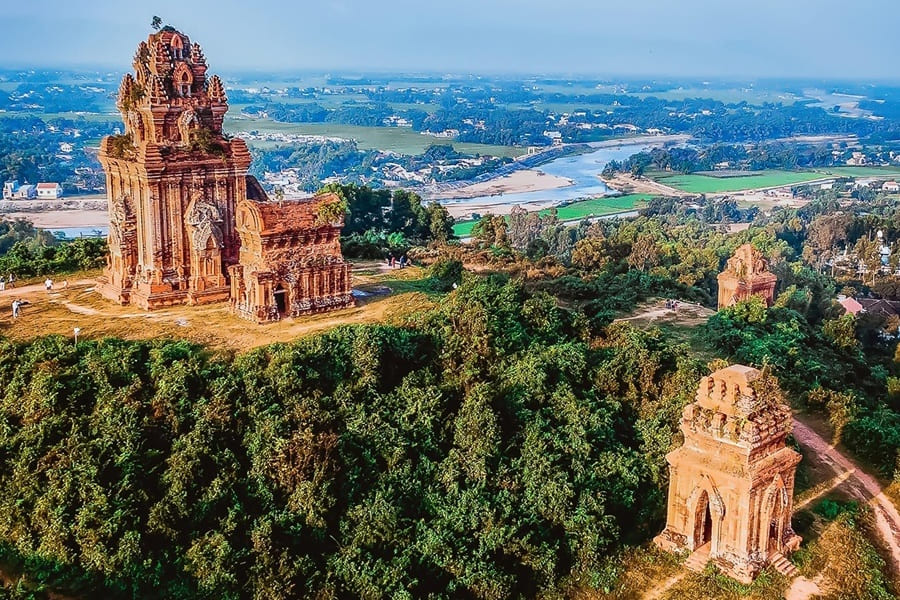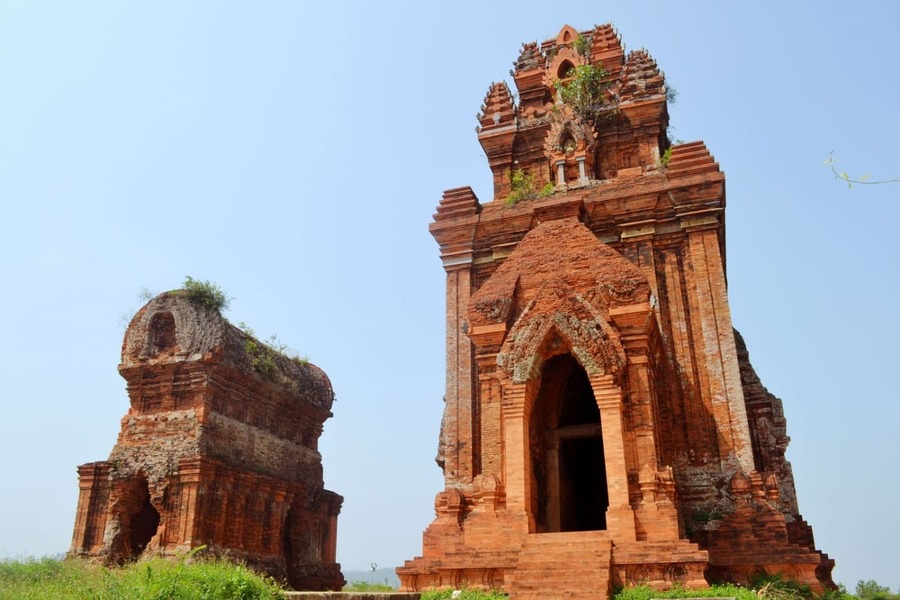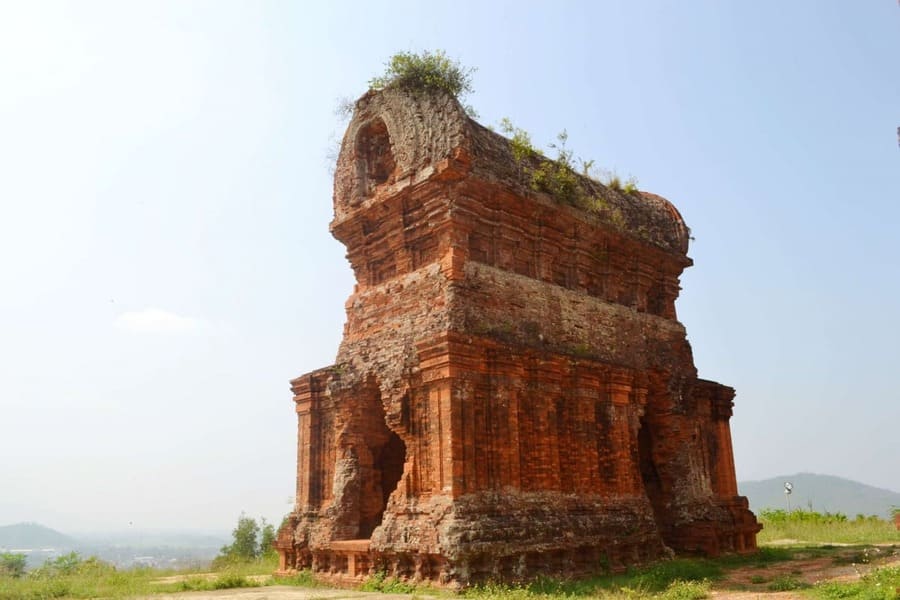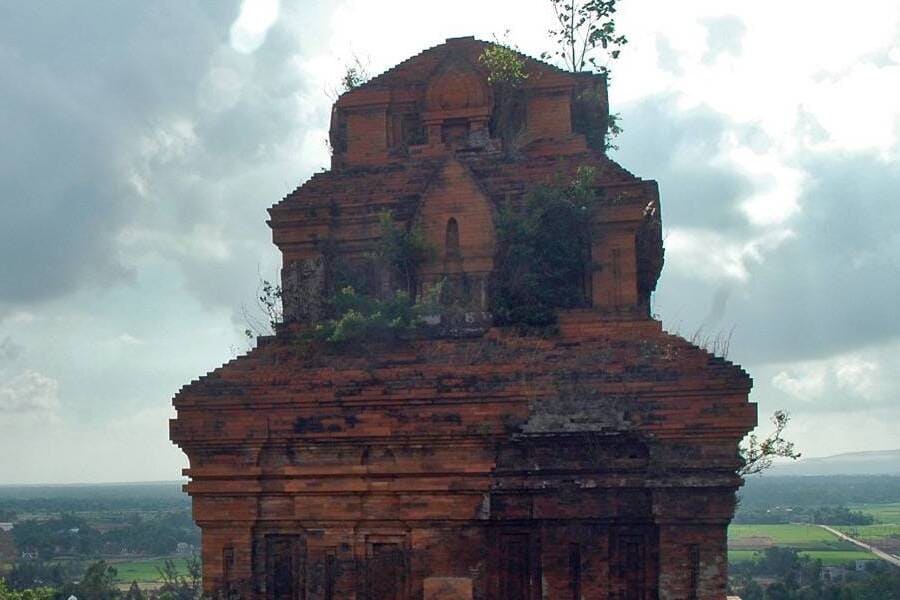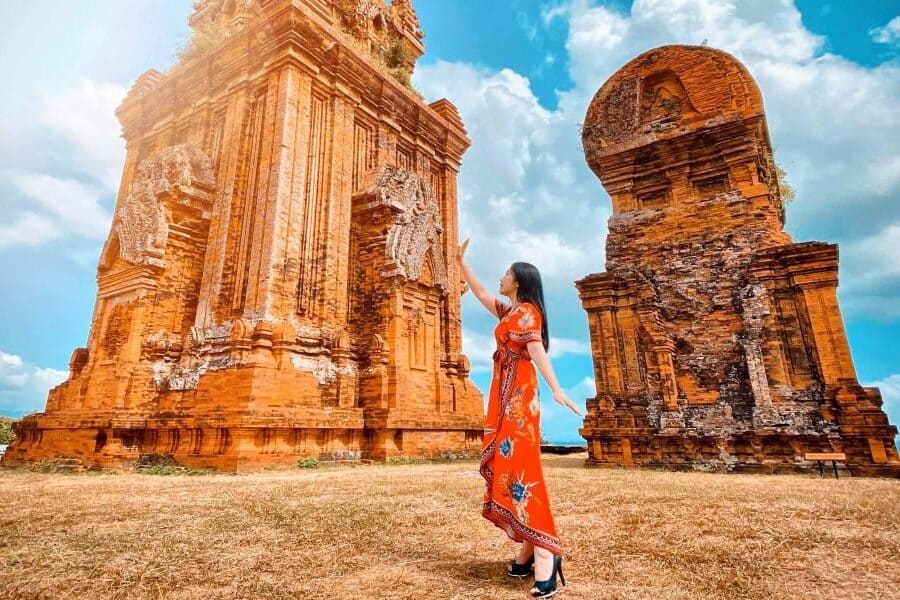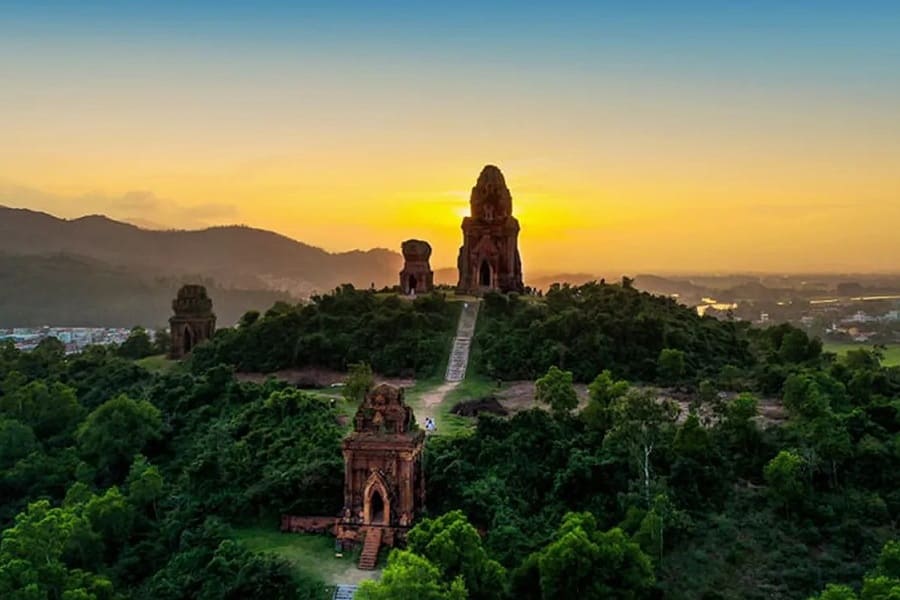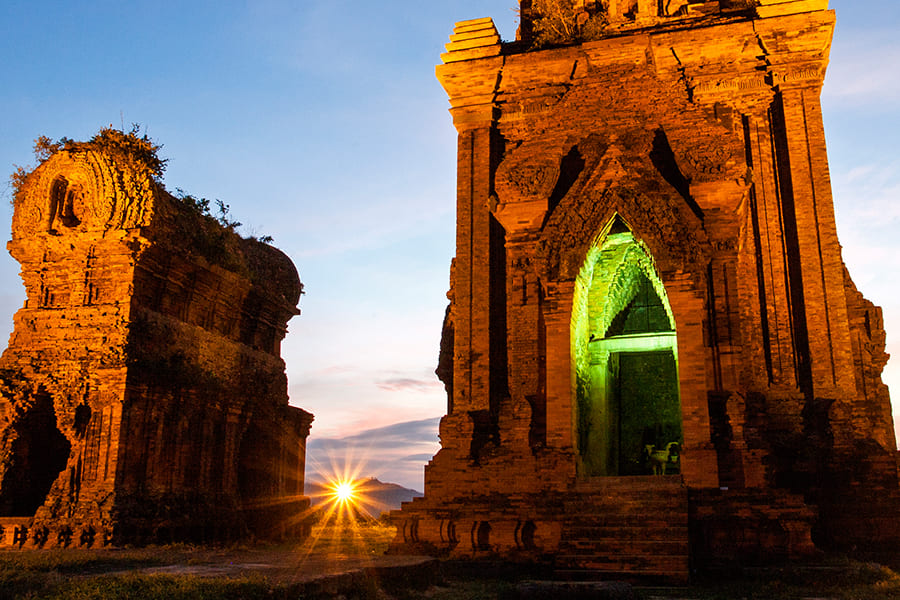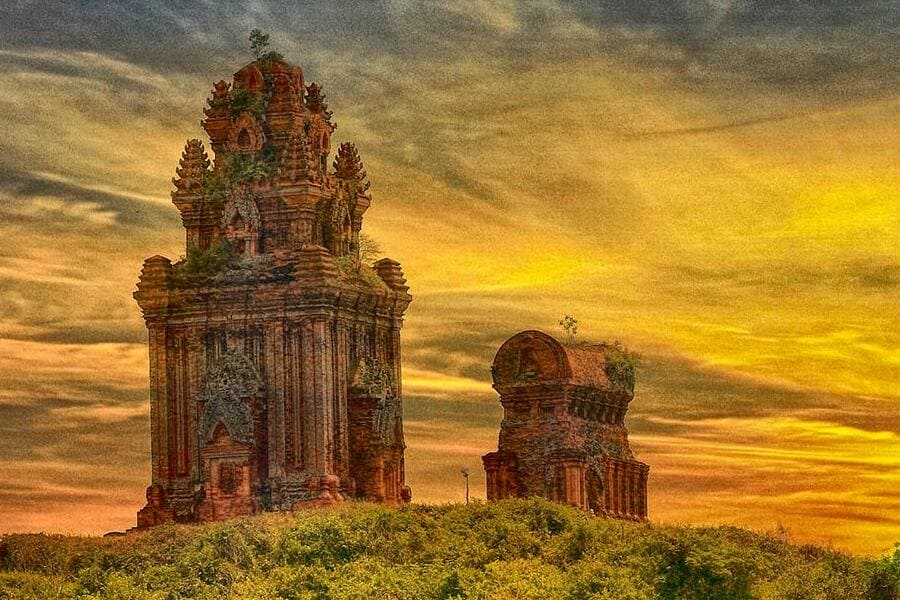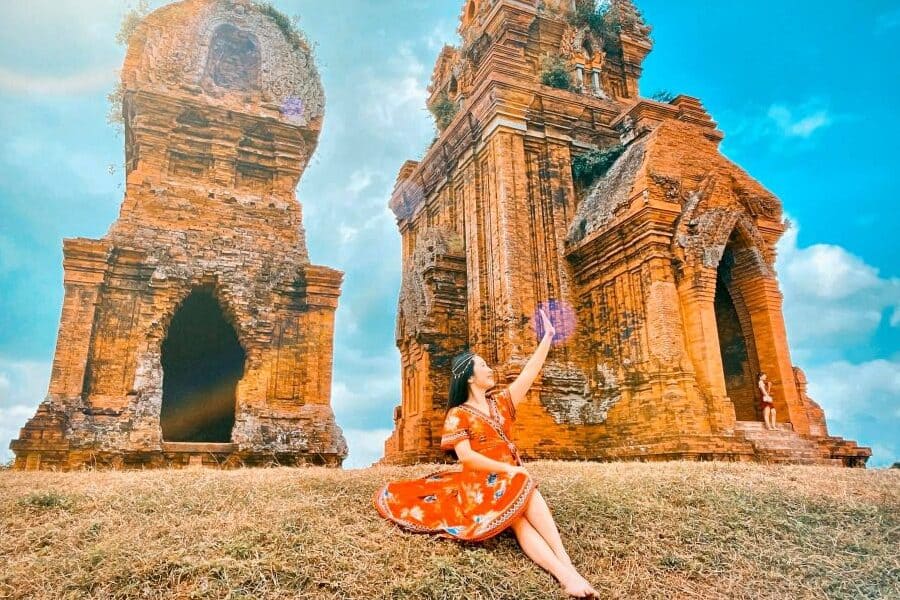Perched gracefully atop a verdant hill overlooking the Con River in Qui Nhon, Vietnam, the Silver Towers, also known as Banh It Towers, stand as magnificent exemplars of Cham architecture. Comprising four distinct towers, each with its own unique style and significance, these ancient structures showcase the Cham people’s profound cultural and spiritual heritage. The tallest and most revered is the Kalan, featuring intricate carvings of Hindu deities and a statue of Shiva, while the Gopura serves as a grand entrance adorned with detailed Cham craftsmanship. The Kosagrha, or Fire Tower, symbolizes spiritual rituals with its blend of sandstone and brickwork, and the Posah, or Beer Tower, offers a glimpse into ritualistic practices. Restored meticulously over time, the Silver Towers continue to mesmerize visitors with their historical charm and architectural splendor, inviting all to unravel their mystique and appreciate their enduring legacy.
About Silver Towers in Quy Nhon
Nestled on a hill over 100 meters high in Dai Le hamlet, Phuoc Hiep commune, Tuy Phuoc district, Binh Dinh, Silver Towers (so-called Banh It Tower) stands approximately 18 kilometers northwest of Quy Nhon’s city center. This site is one of the largest and most significant tower clusters of the ancient Champa kingdom (besides Twin Cham Towers), showcasing unique architectural characteristics that have drawn the attention of researchers and visitors alike.
Banh It Tower is a remarkable relic in Binh Dinh, embodying the grandeur of Champa architecture. According to the chairman of the Binh Dinh General Museum, during the 11th century, when the Cham people moved their capital to Binh Dinh, they constructed temples and towers atop hills to harmonize with the natural landscape, providing a stunning backdrop for their sacred structures. This strategic placement reflects the Cham people’s appreciation for nature and their architectural ingenuity.
The complex of Banh It Tower is considered one of the largest and most diverse architectural sites within the Champa kingdom. Each structure within the complex exhibits unique and creative design elements. The main tower (Kalan) stands as the central piece, surrounded by the gate tower (Gopura), the fire tower (Kosagrha), and the beer tower (Posah). This diversity in architectural styles highlights the artistic and cultural richness of the Cham civilization.
As the largest tower complex among the seven ancient Champa tower clusters in Binh Dinh, Banh It Tower is not only a testament to the architectural brilliance of the Champa dynasty but also a significant cultural and historical landmark. Its distinct structures and picturesque location make it a must-visit destination for those seeking to explore the legacy of Champa culture and its enduring influence on Vietnam’s architectural heritage.
History of Silver Towers
Every expectation for Quy Nhon shore excursions would be fulfilled by the exploration of Banh It Tower’s thousand of years history. The Banh It Towers, also known as the Silver Towers, stand as some of the best-preserved specimens of late Cham architecture. The Cham kingdom, which began its reign over southern and central Vietnam in the second century, reached its peak of dominance in the ninth century. The Cham people embraced Hinduism as their state religion and adapted Indian architectural models to create something uniquely Vietnamese, as best exemplified by the Kalan, the main tower used to worship Hindu deities, notably the deity Shiva.
The Cham kingdom’s dominance began to wane in the tenth century, leading to a decline in the construction of late Cham architecture. Unlike early Cham art, which emphasized simple themes and lacked refinement, late Cham architecture, as seen in the Banh It Towers, showcases greater sophistication and artistic development. The towers were strategically erected on a hill, with the lesser towers situated first, leading up to the great tower, the most significant temple housing a statue of Shiva. The complex is designed in a pyramid-like formation, highlighting the hierarchical significance of the structures.
The Cham people faced constant battles with the Khmers, which resulted in the destruction of several towers. Fortunately, some of these structures were restored before being demolished. The Banh It Towers have withstood the test of time, enduring periods of both devotion and neglect. Restoration efforts, particularly in the twentieth century, have allowed these towers to maintain their architectural intricacy and historical significance. Despite the challenges posed by time and climate, the towers remain resilient on their hilltop perch, offering a glimpse into the grandeur of Cham architecture and the cultural heritage of Vietnam.
Architecture of Silver Towers
The Banh It Towers, also known as the Silver Towers, are celebrated for their unique architectural style that fuses Cham and Hindu design elements. This complex consists of four distinct towers, each showcasing the artistic diversity and craftsmanship of the Cham builders:
The Main Tower (Kalan)
The Main Tower, or Kalan, stands as the central and tallest structure within the Banh It Towers complex, exemplifying the pinnacle of Cham architectural and religious expression. Characterized by its imposing height and distinct design, the Kalan serves a primary role as a sacred temple dedicated to Hindu deities, particularly featuring a statue of Shiva, one of the principal gods revered by the Cham people. Architecturally, the Kalan showcases a classic Cham style with a square-shaped base rising to a pyramidal roof adorned with intricate carvings and sculptures. These decorations depict various Hindu gods, mythical creatures, and scenes from religious epics, illustrating the Cham’s mastery in stone craftsmanship and their devotion to Hindu spiritual practices.
Historically, the Kalan served not only as a place of worship but also as a cultural and educational center where priests conducted rituals, ceremonies, and imparted religious teachings to the Cham community. Its construction reflects the Cham’s assimilation of Hindu architectural elements while incorporating unique regional styles, thereby contributing to the preservation and dissemination of Cham cultural heritage.Today, the Main Tower (Kalan) at Banh It Towers stands as a testament to the Cham civilization’s artistic achievements and religious fervor, attracting scholars, historians, and visitors alike to admire its architectural grandeur and spiritual significance.
The Gate Tower (Gopura)
The Gate Tower, known as Gopura in the context of Cham architecture, serves a pivotal role in the structure of temple complexes. It typically functions as the main entrance to the sacred precinct, marking the transition from the outer world into the inner sanctum reserved for religious rituals and worship. The Gopura is characterized by its ornate and elaborate design, often adorned with intricate carvings and sculptures that depict mythical creatures, deities, and other symbolic motifs significant to Cham religious beliefs. Its architectural style reflects the skilled craftsmanship of the Cham people, who integrated Hindu influences into their own distinctive artistic traditions. As a cultural artifact, the Gopura not only signifies physical entry but also spiritual passage, embodying the profound spiritual and cultural heritage of the Cham civilization.
The Fire Tower (Kosagrha)
The Fire Tower, known as Kosagrha in Cham architecture, holds a sacred role within temple complexes, particularly in the context of Cham religious practices. It is designed to house sacred objects and facilitate ritualistic activities essential to Cham religious ceremonies. The architecture of the Kosagrha typically blends sandstone and brickwork, showcasing intricate carvings and decorative elements that symbolize spiritual significance. Its construction highlights the Cham people’s craftsmanship and their integration of Hindu architectural styles with local artistic traditions. As a pivotal structure in Cham temples, the Kosagrha not only serves as a repository for religious artifacts but also as a focal point for spiritual devotion and community gatherings, embodying the rich cultural and religious heritage of the Cham civilization.
The Beer Tower (Posah)
The Beer Tower, known as Posah in Cham architecture, plays a significant role in the religious and cultural practices of the Cham people. Among the towers within Cham temple complexes, the Posah stands out for its unique architectural style and its specific function in religious rituals. Architecturally, the Posah is typically smaller in size compared to the main tower (Kalan) but is equally adorned with intricate carvings and decorative motifs that reflect Cham artistic craftsmanship. The tower’s design often incorporates elements of Cham and Hindu architectural influences, showcasing a blend of local traditions with external cultural inspirations.
Functionally, the Posah serves as a place for offerings and ritual performances conducted by Cham priests during religious ceremonies. It holds symbolic importance as a site where sacred libations, possibly including offerings of beer or other liquids, are made to honor deities or commemorate spiritual events. Overall, the Beer Tower (Posah) stands as a testament to the Cham civilization’s religious devotion and cultural identity, offering insights into their architectural prowess and spiritual beliefs through its enduring presence in Cham temple complexes.
Located on a prominent hill between the branches of the Con River in Qui Nhon, Vietnam, the Banh It Towers are not only architectural marvels but also cultural symbols of the Cham civilization’s rich heritage. Their preservation and historical significance make them a captivating destination for visitors interested in exploring Vietnam’s diverse cultural and religious history.
Banh It Towers’s Cultural and Religious Significance
Banh It Towers hold immense cultural and religious significance, reflecting the rich heritage and spiritual traditions of the Cham people. Constructed during the Cham kingdom’s heyday, these towers are a testament to the Cham civilization’s architectural prowess and religious devotion.
Cultural Significance
Architectural Masterpiece: Banh It Towers are among the best-preserved examples of late Cham architecture, showcasing the unique blend of Cham and Hindu architectural styles. The intricate carvings and towering structures demonstrate the advanced construction techniques and artistic capabilities of the Cham people.
Symbol of Cham Civilization: These towers are a symbol of the Cham kingdom’s historical and cultural achievements. They offer a glimpse into the daily lives, beliefs, and social structure of the Cham people, contributing to the understanding of Vietnam’s diverse cultural heritage.
Historical Insight: The towers provide valuable insights into the Cham kingdom’s history, including their interactions with neighboring civilizations like the Khmer Empire. The architectural influences seen in the towers highlight the cultural exchanges that took place during that era.
Religious Significance
Hindu Influence: The Cham people adopted Hinduism as their state religion, and the Banh It Towers were constructed as temples to honor Hindu deities. The primary deity worshipped here is Shiva, as evidenced by the prominent Shiva statue in the main tower, known as Kalan.
Spiritual Center: The towers served as important spiritual and ritual centers for the Cham people. They were places of worship, meditation, and religious ceremonies, playing a crucial role in the community’s spiritual life.
Sacred Art: The carvings and sculptures adorning the towers depict various Hindu deities, mythological creatures, and religious symbols. These artistic elements not only enhance the towers’ aesthetic appeal but also convey the religious narratives and spiritual beliefs of the Cham people.
Preservation and Legacy
Historical Preservation: Despite the passage of time and historical upheavals, the Banh It Towers have been preserved and restored, allowing future generations to appreciate their historical and cultural value. Restoration efforts in the 20th century have helped maintain their structural integrity and intricate details.
Cultural Heritage: Today, the Banh It Towers stand as a significant cultural heritage site, attracting researchers, historians, and tourists. They continue to inspire awe and admiration for the Cham civilization’s rich cultural legacy and religious devotion.
In summary, the Banh It Towers are not just architectural marvels but also cultural and religious symbols that encapsulate the essence of the Cham civilization. They offer a profound connection to the past, providing insights into the spiritual and cultural life of the Cham people and their enduring legacy.
What to do when visiting Silver Towers?
Banh It Towers offers a panoramic view of the surrounding landscape which is a mark in your Vietnam shore excursions, including the Thi Nai River, Truong Son mountains, and the ocean. Visitors can explore the different towers, each showcasing unique architectural styles and historical significance. The complex provides a serene escape from the hustle and bustle of Quy Nhon, allowing visitors to immerse themselves in the rich history and spiritual ambiance of the Cham civilization.
Embark on a journey into the mystique of the Silver Towers, where history, artistry, and spirituality converge in a timeless exploration of Cham architecture. Whether you’re a historian, an art enthusiast, or a traveler seeking to delve into Vietnam’s rich cultural tapestry, the Silver Towers promise an unforgettable experience filled with wonder and enlightenment.
How to get to Silver Towers from Quy Nhon city center?
To get to the Silver Towers (Banh It Towers) from Quy Nhon city center, tourists can:
By Taxi or Private Car: Taxi and private cars are readily available in Quy Nhon. You can book one through your hotel or a local taxi service. Head northwest from the city center. The journey is approximately 18 kilometers. The drive takes about 30-40 minutes, depending on traffic.
By Motorbike: You can rent a motorbike from various rental services in Quy Nhon. Start by heading northwest on Tran Hung Dao Street.
Continue onto National Route 1D (QL1D). Turn left onto DT638 (Provincial Road 638) towards Dai Loc village in Phuoc Hiep commune. The ride takes about 35-45 minutes.
By Bicycle: If you’re up for a bit of exercise, renting a bicycle is a great option. Follow the same route as the motorbike directions. The journey may take around 1.5 to 2 hours, depending on your pace and stamina.
Tips for the Journey
- Maps and Navigation: Use a GPS-enabled device or a map to help navigate the route.
- Safety Gear: If you’re riding a motorbike or bicycle, ensure you wear appropriate safety gear like helmets.
- Weather: Check the weather forecast and plan your trip accordingly to avoid rain and extreme heat.
- Hydration and Snacks: Bring water and snacks, especially if you’re cycling.
The Silver Towers, perched on a hill, offer a captivating view and an insight into the Cham culture, making the journey well worth the effort.

